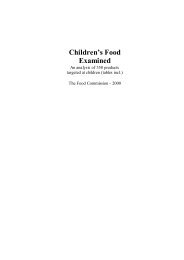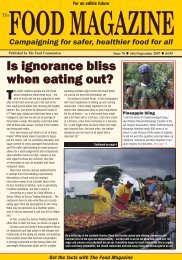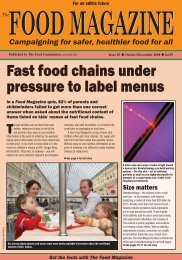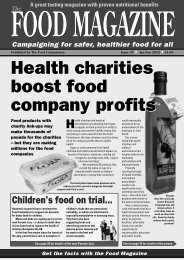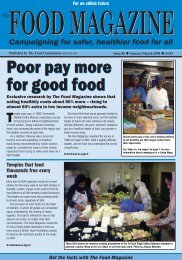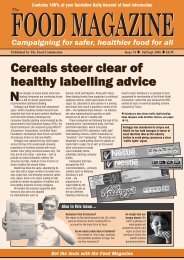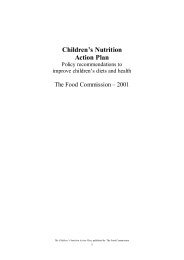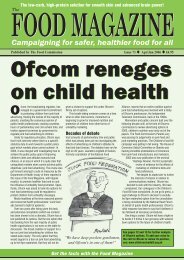Kids’ <strong>Food</strong> for Fitness You don’t have to be the parentof an aspiring athlete to benefit from Anita Bean’s excellentbook. It’s full of great everyday advice, including: <strong>The</strong> latestnutritional guidelines for active children aged 5–16; Clear practicaladvice on nutrition and exercise; Tips on eating and drinking for sporty kids;Smart advice for overweight children; Healthy menu plans, tastyrecipes and snack ideas. Special offer – £12.99Dump the Junk!Containing over 300 expert tips for how to encourage yourchildren to eat healthy food and dump the junk, and withlots of tasty recipes, this is an essential guide for parents.Illustrated with entertaining cartoons by the <strong>Food</strong>Magazine’s Ben Nash. £7.99<strong>The</strong> <strong>Food</strong> Our Children Eat – 2nd editionHow can you bring up children to chomp on clementines rather than colachews? Award-winning author Joanna Blythman’s book is an inspiringguide for parents. From weaning a baby to influencing a teenager, sheexplains how to bring children up to share the same healthy and wideranging food tastes as you. No more tantrums, fights and refusals: herstrategies are relaxed, low-effort – and they work. £8.99Fast <strong>Food</strong> Nation – now in paperbackEric Schlosser’s bestseller lifts the lid on thefast food industry. He explores how fakesmells and tastes are created, talks toworkers at abattoirs and explainshow the fast food industry is transforming not onlyour diet but our landscape, economy, workforceand culture. Essential reading. £7.99order formBack issues of the <strong>Food</strong> MagazineBack issues usually cost £3.50 each but we’reselling a full set of available issues (approx.eighteen issues from 1996 to 2003) for £30.00. Sendfor index of major news stories and features in pastissues. Stocks are limited and manyissues are already out-of-stock.publications all prices include postage & packingKids’ <strong>Food</strong> for Fitness £12.99 ❍Dump the Junk! £7.99 ❍<strong>The</strong> <strong>Food</strong> Our Children Eat – 2nd edition £8.99 ❍Fast <strong>Food</strong> Nation £7.99 ❍Full set of available back issuesof the <strong>Food</strong> Magazine £30.00 ❍<strong>The</strong> Chips are Down £15.00 ❍<strong>The</strong> NEW Shopper’s Guide to Organic <strong>Food</strong> £9.99 ❍Children’s Nutrition Action Plan £10.00 ❍Broadcasting Bad Health £10.00 ❍Poster – Genetically Modified <strong>Food</strong>s £2.50 ❍Poster – Children’s <strong>Food</strong> £2.50 ❍Poster – <strong>Food</strong> Labelling £2.50 ❍Poster – <strong>Food</strong> Additives £2.50 ❍List of available back issues free ❍subscriptionsIndividuals, schools, public libraries £22.50 ❍OVERSEAS individuals, schools, libraries £30.00 ❍Organisations, companies £46.00 ❍OVERSEAS organisations, companies £54.00 ❍<strong>The</strong> <strong>Food</strong> Magazine is published four times a year.Your subscription will start with our next published issue.marketplace<strong>The</strong> Chips are DownThis is an excellent guide to the planning and promotion ofhealthy eating in schools, full of nitty-gritty guidance, suchas how to gain support from teachers, parents, healthworkers and, most importantly, pupils. £15.00<strong>The</strong> NEW Shopper’s Guide toOrganic <strong>Food</strong>Is organic food worth the extra expense? How does itcompare with non-organic? Is it all it’s cracked up tobe? Lynda Brown tackles these questions and more in her NEWShopper’s Guide to Organic <strong>Food</strong>s. <strong>Food</strong> writer Nigel Slaterdescribes it as ‘Essential reading for anyone who cares aboutwhat they put in their and their children’s mouths.’ £9.99Children’s Nutrition Action Plan<strong>The</strong> <strong>Food</strong> <strong>Commission</strong>’s action plan details what UK childrenare eating and health problems likely to arise as a result. <strong>The</strong>action plan maps measures advocated by governmental andnon-governmental organisations to bring about change, andhighlights key policies that could make a difference to children’s health. £10.00Broadcasting Bad HealthPacked with illustrations, case studies and statistics on trends in health and foodadvertising around the world, this report sets out the case for why food marketing tochildren needs to be controlled. Available free of charge in pdf format on the website(see below) or in print for £10.00Posters: GM <strong>Food</strong>s; <strong>Food</strong> Additives,Children’s <strong>Food</strong>; <strong>Food</strong> LabellingPacked with essential information to help you andyour family eat healthy, safe food these postersexplain problems with GM technology; give usefultips on getting children to eat a healthy diet;explain how to understand nutrition labelling; helpyou see through deceptive packaging and marketingclaims and examine the contentious issue of foodadditives. Each poster is A2 in size and costs £2.50payments / donationsPlease tick items required and send payment by cheque, postal order or credit card.Overseas purchasers should send payment in £ sterling, and add £1.50 per book for airmail delivery.Name:PaymentDonationTotalI have enclosed a cheque or postal order made payable to <strong>The</strong> <strong>Food</strong> <strong>Commission</strong>Please debit my Visa or MastercardMy credit card number is:Card expiry date:Signature:Address:Postcode:Date:Send your order to: Publications Department, <strong>The</strong> <strong>Food</strong> <strong>Commission</strong>, 94 WhiteLion Street, London N1 9PF. Tel: 020 7837 2250. Fax: 020 7837 1141.Email: sales@foodcomm.org.ukDelivery will usually take place within 14 days.www.foodcomm.org.ukVisit our website for a full list of ourpublications, posters and reports<strong>Food</strong> Magazine 64 18 Jan/Mar 2004
scienceWhat the doctor reads<strong>The</strong> latest research from the medical journalsExercise does notprevent obesityTwo papers from the Danish EpidemiologyScience Centre have examined the gradualonset of obesity in adults and found noevidence that physical activity patterns couldpredict who would gain weight, althoughobese people did take less exercise.Researchers monitored 6,000 adults acrossa 15-year period and also 2,000 men over a 40-year period. If anything, physical activitylevels were higher among those that laterdeveloped obesity.<strong>The</strong> researchers suggest that obesitydevelops from factors other than physicalinactivity or lack of exercise, but that onceestablished obesity leads to a reducedwillingness to take exercise – possibly due tothe discomfort of sweating andbreathlessness. Social factors – e.g. showingoneself in public changing rooms and gyms –may also be involved.■ H Bak et al, Int J Ob, 2003; L Petersen et al, Int JOb, 2004.25% cut in salt undetectedAn experiment in which the salt level inbread was cut by 5% every week for fiveweeks found that the reduced salt could notbe detected. Ratings of the saltiness and theflavour of the bread were no different tothose made by a control group whose breadwas not altered. <strong>The</strong> authors recommendthe bread industry to make small, repeatedadjustments to lower the overall salt burdenon the population, in order to reduce the riskof hypertension and stroke.■ S Girgis et al, Eur J Clin Nutr, 2003.Self-reported dietsunderestimate caloriesA comparison between the amounts of foodwomen said they were consuming and theamounts they would need according to theirweight, height and metabolic levels showedthat self-reported diets were typically morethan 400kcal per day below the expectedlevels.Over a quarter of women under-reportedby more than 800kcal per day. In the study (ofover 160,000 US women) those with higherBMIs tended to underreport more: at BMI 35underreporting was about 330 kcalories perday greater than at BMI 20.■ JR Hebert et al, Annal Epidem, 2003.Fast food is linked topoor dietA study of over 6,000 children showed thatthe diets of those eating fast foods is pooreroverall than the diets of those not eatingfast food, and that children have better dietson days that they do not eat fast food.On days when fast food was consumed,the survey of a nationally representativesample of US children found:higher energy intake (up 126 kcal/day)higher energy density (up 0.3 kcal/gram)more fat (up 7g/day)more saturated fat (up 3g/day)more added sugars (up 21g/day)more soft <strong>drinks</strong> (up 189g/day)smaller amounts of fruit and vegetables(down 47g/day).Typically, nearly a third of children reportedeating fast food on any given day.■ SA Bowman et al, Pediatrics, 2004.Organic plants containmore salicylic acidA comparison of commercial soups madeusing organic and non-organic vegetablesfound the former to have significantly higherlevels of naturally-occurring salicylic acid, theactive ingredient found in aspirin.Although levels were lower than would befound in pharmaceutical doses, if the overalldiet contains substantial amounts of organicproduce then the total effect may becomparable.Levels of salicylic acid in the blood of somevegetarians is as high as it is in some patientson regular low-dose aspirin prescribed forheart disease prevention.■ GJ Baxter et al, EFRC Bulletin, Dec 2003.Guidance sought oncalorie countingSeveral journalists and other individualshave contacted us over the past fewmonths asking how to calculate the amountof activity needed to burn off calories. <strong>The</strong>following chart shows approximate calorieexpenditure for a range of activities:Activity Kcalories used in 20minutes of activityAerobic dancing – lowintensity, equivalent to walking 80Aerobic dancing – mediumintensity, equivalent to jogging 130Aerobic dancing – high intensity,equivalent to running 170Bed making 100Cleaning windows 60Cleaning stairs 65Climbing stairs (72 steps per minute) 95Climbing stairs (92 steps per minute) 130Cycling on flat ground (‘own speed’) 125Dancing (waltz) 130Dusting 70Gardening 110Golf 100Knitting 25Office work (general) 25Operating electric sewing machine 25Playing cricket 160Playing pool 65Playing squash 200Playing tennis 140Playing football 140Playing table tennis 90Playing cards 40Running (speed unspecified) 190Sitting typing 30Walking on the level (1-2 km per hour) 45Walking on the level (4-5 km per hour) 85Watching football 40■ Source: Human Energy Requirements: Amanual for planners and nutritionists, byWPT James and EC Schofield, published bythe Oxford University Press (1990).<strong>Food</strong> Magazine 64 19 Jan/Mar 2004



